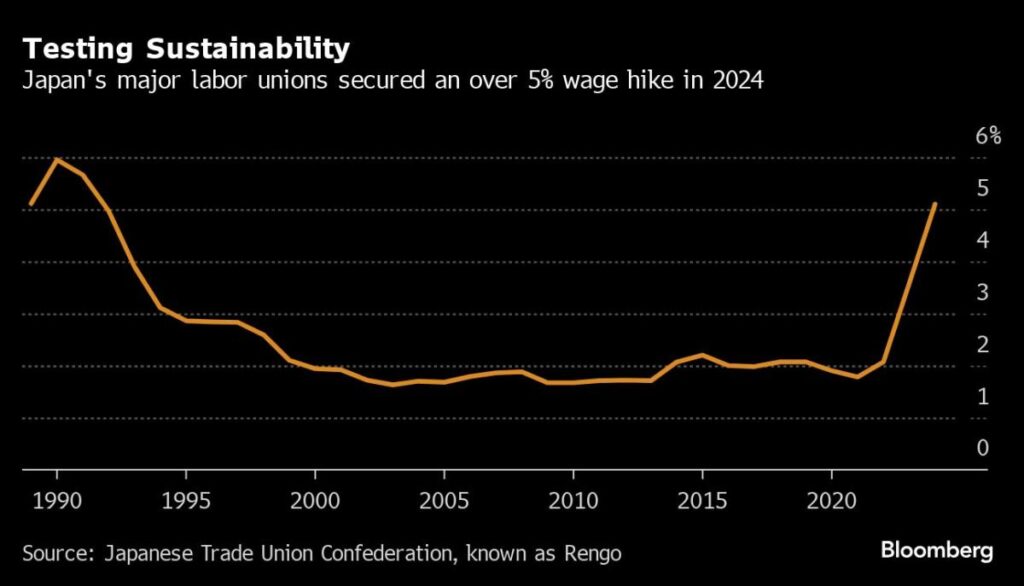Japan’s largest labor union federation, Rengo, has set an ambitious target for the upcoming year’s pay negotiations, aiming for an average wage increase of at least 5%. This goal comes on the heels of a notable achievement in 2024 where workers saw an average wage hike of 5.1%, marking the largest increase in 33 years. Rengo’s president, Tomoko Yoshino, emphasized the importance of continued wage hikes, stating that the momentum needs to be maintained to firmly establish wage growth. The issue of pay is gaining heightened attention as it directly relates to the overall health of Japan’s economy, influencing both Prime Minister Shigeru Ishiba’s political future and the monetary policy directions taken by the Bank of Japan (BOJ).
As Japan approaches a crucial general election on October 27, wage trends have become a focal point in political discussions. Prime Minister Ishiba is under pressure to deliver on his promise of real wage growth, following voter dissatisfaction linked to rising living costs that led to the resignation of his predecessor, Fumio Kishida. Economic sentiments among consumers stress the need for stability, with calls for the government to ensure that wage growth and price stability are achieved simultaneously. Shinichiro Kobayashi, a chief economist, articulates that voters are primarily concerned about their wages and the impact of inflation, reflecting a broader societal demand for economic improvement.
Ishiba’s strategy has involved pledging to eradicate deflation while securing wage growth that surpasses inflation rates. Recent data indicated a 2.4% rise in consumer inflation in September, sustaining the trend of inflation at or above the BOJ’s 2% target for 30 consecutive months. However, the challenge lies in the recent dip of real wages back into negative territory after a brief period of gains, raising concerns about Ishiba’s capacity to meet his campaign promises. In an effort to bolster support, he has tasked ministries with developing an economic package to promote wage growth, particularly for rural areas, although details of this initiative remain vague.
Opposition parties are also actively campaigning on platforms aimed at improving household financial conditions. The Constitutional Democratic Party, for example, has suggested lowering the BOJ’s target inflation rate from 2% to “above 0%,” while other parties have proposed tax cuts, including reductions in the consumption tax. The BOJ’s decision-making process is expected to factor in these wage negotiations closely, particularly after last year’s optimistic outcomes influenced its policy decisions. Eiji Maeda, a former BOJ executive, highlighted that the momentum of wage hikes could lead to future rate increases, with speculation about potential changes occurring as early as December.
Despite the momentum in wage growth, several challenges loom on the horizon. While companies reported robust earnings last year, bolstered by the weak yen benefiting exporters such as Toyota, the currency has gained strength against the dollar recently. This shift, coupled with a cooling economy in the US and China, might hinder Japanese companies’ ability to provide significant pay increases. Additionally, the financial strain on smaller firms, which often struggle to match the pay hikes offered by larger enterprises, remains a significant concern. For instance, Rengo reports that in 2024, businesses with fewer than 300 employees managed an average wage increase of 4.45%, and the federation is advocating for a rise of at least 6% for these firms in the next round of negotiations.
Finally, despite ongoing challenges, Japan’s persistent labor shortage could continue to drive wage growth. Many companies, such as Suntory Holdings, have acknowledged the necessity of raising wages to attract and retain talent. Nevertheless, the ongoing financial constraints for several businesses, particularly small firms struggling with rising labor costs, could complicate efforts to boost salaries consistently. The Tokyo Shoko Research reported a record number of bankruptcies due to labor shortages this year, underlining the delicate balance between maintaining operational capacity and ensuring competitive wages in the current economic landscape. The forthcoming negotiations will be pivotal to addressing wage disparities and securing the livelihoods of workers across various sectors.

